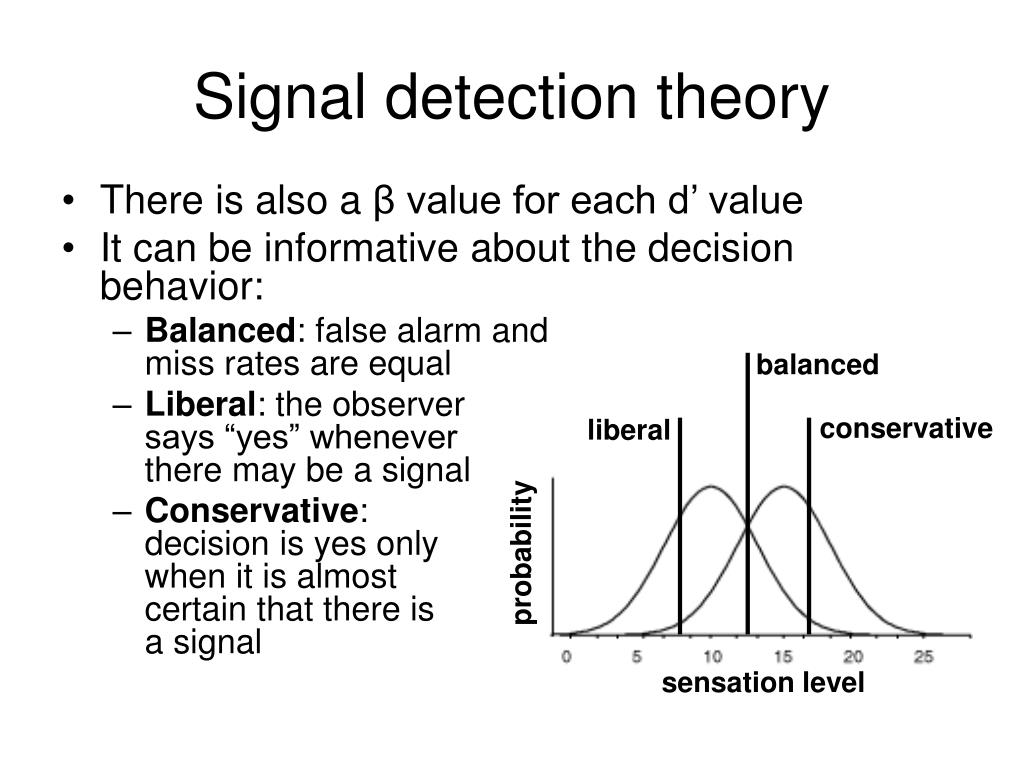

The outcome that occurs when the response that is made is not the one that should have been made given the definition of the task. The higher the difficulty, the lower the sensitivity, and vice versa. In a signal detection task, it refers to how hard it is to distinguish whether a signal is present or absent.
#SIGNAL DETECTION THEORY EXPLAINED TRIAL#
In a signal detection task, it is the process that leads on each trial from the stimulus, which might have a signal present or absent, to a response, which might be ‘present’ or ‘absent’, or to no response. Or even more broadly, “a commitment to a course of action that is intended to yield results that are satisfying for specified individuals” ( Yates & Tschirhart, 2006). The selection of an action (or lack thereof) in a particular circumstance. The author takes great joy in this sort of thing. The stylization of the ‘d’ as d′ and the ‘c’ as c is a nod to the two key parameters of signal detection theory. The word is a portmanteau of ‘detection’ and ‘explorable’. The explorable explanation of signal detection theory that this glossary is a part of. It may take on any value between negative infinity and infinity, with negative values indicating the signal-plus-noise distribution is below the noise distribution, and positive values indicating the signal-plus-noise distribution is above the noise distribution. It is defined as the distance between the mean of the noise distribution and the signal-plus-noise distribution. d′Ī measure of sensitivity in signal detection theory. The outcome that occurs in a signal detection task when the signal is absent, and the participant correctly responds ‘absent’. In a signal detection task, this occurs when the signal is present and the participant responds ‘present’ or the signal is absent and they respond ‘absent’. The outcome that occurs when the response that is made is the one that should have been made given the definition of the task. In our formulation of signal detection theory, this would be represented by a positive value for the parameter c. conservative biasĪ tendency to respond that a signal is ‘absent’ more often than that it is ‘present’. In a random dot kinematogram, it refers to dots moving in the same direction in a stimulus. Motion in the same direction by multiple objects in a display. It may take on any value between negative infinity and infinity, with negative values indicating a threshold below the neutral point, and positive values indicating a threshold above the neutral point. It is defined as the distance of the decision threshold from the neutral point exactly half way between the noise distribution and the signal-plus-noise distribution. cĪ measure of response bias in signal detection theory. Some factors may be varied within each block, while others may be varied across blocks. A typical design of such an experiment is to have one or more experimental sessions, each of which consist of one or more blocks, each of which consist of many trials. blockĪ sequence of trials in a psychology experiment. The tendency to make one response (either ‘present’ or ‘absent’) more than the other in a signal detection task.

For a signal detection task, the proportion of all trials for which the signal is present. The proportion of all events that are of a specified type. An overall measure of performance defined as the proportion of all responses that are correct responses as opposed to error responses.


 0 kommentar(er)
0 kommentar(er)
